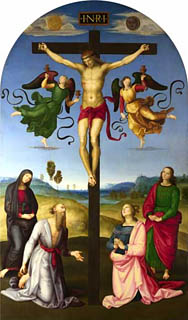Meet Raffaello Sanzio from Urbino: an urbane and smooth-shaven young man, with the trace of a pout, long floppy hair poking out from under his plain black cap, and an expression of dreaminess, mingled with cool self-assurance, in his almond-shaped eyes. This may or may not be exactly how Raphael looked, circa 1505-9, but it is certainly how he liked to see himself, to judge by his earliest extant painted self-portrait. Owned by the Uffizi Gallery in Florence, the picture is currently on loan to the National Gallery for “Raphael: From Urbino to Rome”, an enthralling exhibition of around 100 works, more than 80 by Raphael himself, exploring the formative years of this Renaissance prodigy. Possibly unfinished, considerably abraded and restored several times over the centuries, the painting is something of a wreck – Edward Gibbon once disappointedly pronounced it to be “without expression, without drawing and without colour” – but it eloquently communicates one simple fact about the man whose image it perpetuates. Raphael reached the summit of his profession at a very early age.
The youth in the Uffizi Self-Portrait looks barely out of adolescence but he was capable, none the less, of taking Rome by storm, of matching the considerably older Michelangelo brushstroke for brushstroke, and of winning the pick of the commissions from that most redoubtably choosy of Renaissance papal patrons, Julius II. To underline that their exhibition is, among other things, a study in exceptional precocity, the organisers of the National Gallery show have hung the painting right at its end, as a kind of coda. It comes as something of a shock to be reminded that this is how Raphael looked after he had already achieved so much.
Raphael’s precocity amazed his contemporaries – although Michelangelo was more than a little irritated by it...

Raphael at the National Gallery
30-11-1999

